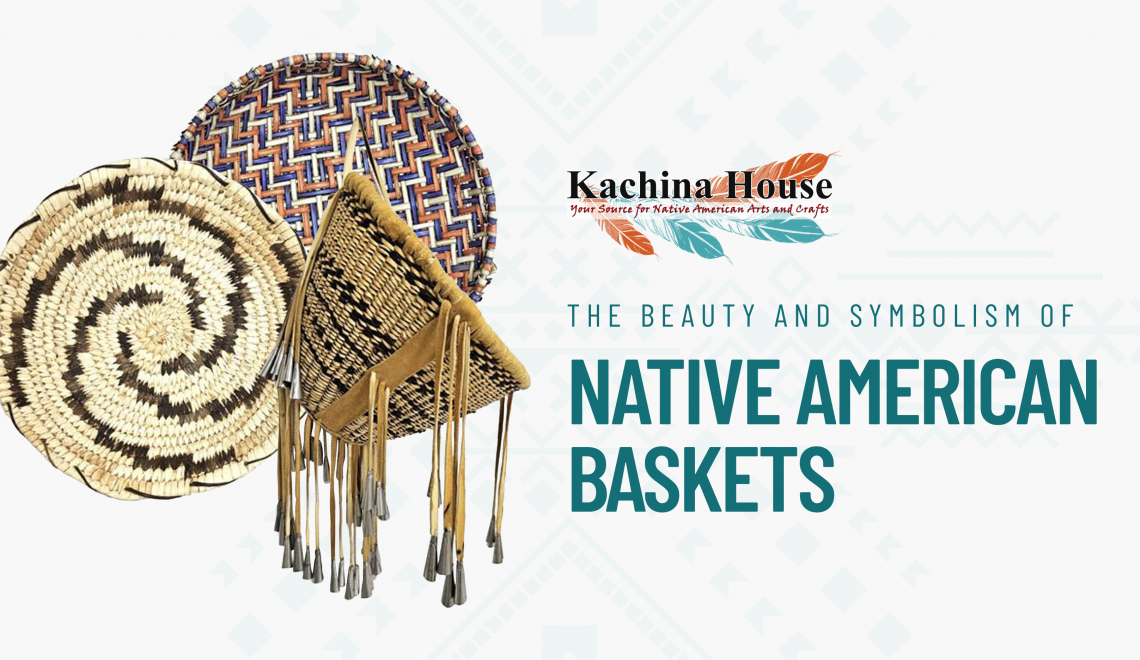
Baskets have been a part of human life for thousands of years. People around the world have used them for carrying, storing, serving, and even for decoration. Made from natural materials like grasses, leaves, and wood, baskets are one of the oldest and most useful tools created by hand. Among the most admired and meaningful baskets in the world are those made by Native Americans. They are works of art, symbols of culture, and part of traditions passed down through generations.
In this post, we will look at how Native American baskets are made, what their patterns mean, and the different types of baskets found across tribes.
How Are Native American Baskets Made?
First, let’s learn how to make these beautiful and meaningful baskets. Native American baskets are made by skilled artisans from tribes across North America. Basket making is a traditional craft that has been passed down through families for generations. Each tribe has its styles, tools, and materials, based on the land they live on and the purpose of the baskets they create.
Some baskets are made for everyday use, while others are used in ceremonies or given as gifts. The process takes time, care, and knowledge of nature. Here is how most Native American baskets are made:
Gathering materials: Basket makers begin by collecting natural materials like willow, yucca, river cane, pine needles, or sumac. These are picked during certain seasons to make sure they are flexible and strong.
Preparing the fibers: Once the materials are gathered, they are cleaned, soaked, and sometimes split into thin strips. Some are dyed using natural colors made from plants, berries, or minerals.
Weaving the basket: Different tribes use different weaving methods, such as coiling, twining, or plaiting. The artist carefully works the materials into shape, making sure the basket is strong and even.
Finishing touches: Once the basket is shaped, the rim is finished with strong and neat weaving. Some artists add special touches like wrapped edges, handles, or designs made with colored fibers.
Types of Native American Baskets
Native American baskets come in a wide variety of styles and purposes, reflecting the diverse cultures and environments of the tribes that create them as well as the purpose for which the baskets are woven. There are many types of baskets made by Native American tribes; here are some of the most popular:
Burden Baskets
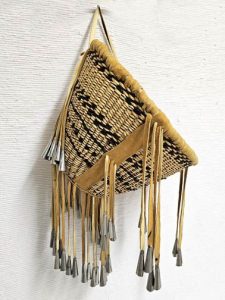
Made by: Apache, Hopi, and other Southwestern tribes
Burden baskets are some of the most recognizable types of Native American baskets because of their unique design. These baskets were traditionally made with a forehead strap (trump line), allowing the basket to rest on a woman’s back and leaving her hands free for gathering crops or doing other daily tasks.
Among the Hopi and Apache people, burden baskets had cultural meaning. In some traditions, they were hung outside the home at the end of the day. Visitors would place their worries, or “burdens,” into the basket before entering, believing that the wind would carry those troubles away.
Sifter Baskets
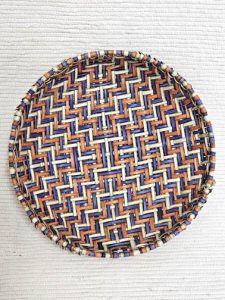
Made by: Hopi
Hopi women from all three mesas weave sifter baskets using the fibers of the yucca plant. These baskets are made by plaiting the fibers in a way that leaves small gaps, which allow grains and seeds to be sifted through and chaff to be held back. That’s how they get their name.
Besides their everyday use for preparing cornmeal or separating seeds, these baskets also play a role in ceremonies. The fibers are often dyed using natural colors to create beautiful patterns and meaningful designs.
Split Ash Baskets
Made by: Iroquois and Chippewa
These baskets are crafted using thin strips of black ash wood. The wood is stripped from the tree and soaked until it becomes soft enough to weave. Because the black ash tree has a straight trunk, it is perfect for making evenly sized strips.
The result is a basket that is both sturdy and beautiful. The light and dark shades of ash create eye-catching patterns that are often more decorative than practical. Still, many are used for storage and gifts, especially in traditional events and gatherings.
Papago Baskets
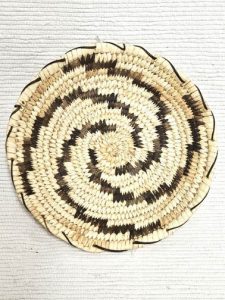
Made by: Tohono O’odham (formerly known as the Papago)
The Tohono O’odham people, also known as the Desert People, live in the Sonoran Desert. Their baskets are made using an open coil technique. In this method, bundles of grasses are stacked and then tightly stitched together with strips of yucca.
These baskets are strong and dependable, made to store food and other items. While they are very practical, many are also beautifully woven and serve as artistic expressions of tribal identity.
Coiled Baskets
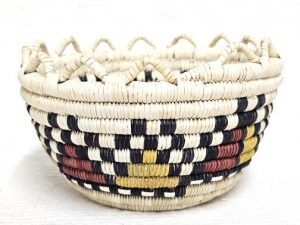
Made by: Apache, Hopi, Tohono O’odham, and other Southwestern tribes
Coiled baskets are made by winding materials like willow, devil’s claw, or yucca in a tight spiral and stitching them in place. This method allows for baskets that are thick, durable, and often highly detailed.
Some coiled baskets tell stories through pictures woven into the design. These baskets are often used in ceremonies or given as gifts, making them both meaningful and visually stunning.
What Do the Patterns on Native American Baskets Mean?
Iff you’ve already learned about the different types of Native American baskets, you might be wondering, what about the designs? What do all those beautiful shapes, lines, and colors mean?
As a matter of fact the patterns woven into Native American baskets are far more than decoration. They hold meaning, often passed down through generations, and tell stories, show identity, or reflect the world around the weaver.
Below are some common meanings behind the patterns:
Nature and the environment: Many patterns show symbols from nature like mountains, rivers, clouds, animals, stars, or the sun. These symbols reflect how connected the people are to the land and natural cycles.
Spiritual beliefs: Spirals, zigzags, and circles often represent spiritual ideas such as life cycles, journeys, wind, or water. These patterns can also point to sacred directions or elements.
Tribal or family identity: Certain patterns are special to specific tribes or clans. Just like a family crest, these designs let others know where the basket came from and who made it.
Protection and balance: Some designs are believed to protect the user or keep spiritual balance. These might include repeating shapes or mirrored designs.
Storytelling: In some cases, the entire basket is a story. For example, a weaver may use different shapes and colors to represent a legend, a hunting trip, or even dreams.
Since different tribes and clans have different traditions, the exact meaning of each pattern can vary. A zigzag might mean water to one tribe, while to another it could represent a snake or a path through the mountains.
What makes these patterns special is that they are woven by hand, often without a guide or written plan. The weaver uses memory, skill, and personal expression to bring the design to life.
Conclusion
As you can see, Native American baskets are more than simply handmade objects. They are living stories, cultural treasures, and examples of skill passed down through generations. From gathering natural materials to weaving each design by hand, every basket shows a deep respect for tradition, nature, and community.
If you are interested in learning more or owning a piece of this amazing tradition, visit Kachina House. There you can find real Native American baskets and other traditional art.


Hello thank for putting informative and well written information on the internet on this topic. I’ve had quite a number and varieties of Native American baskets over the years as well as Native American art, artifact and other related things. I’m from Dallas/Fort Worth TX so have been regionally fairly close to many of the aforementioned things but just for the last 7 years I’ve been located in Florence, SC. I happened on to an old Native American, pretty tightly woven basket lid only in a garage sale and I would love a general opinion on what type of basket it might accompany. Is there a way for me to take a few pictures and send? It would be greatly appreciated if so. Thank you in advance.
We are grateful you like our basket information. Indeed, you can email us a few pix of your basket. Be sure to include the size of it. email is info@kachinahouse.com We are happy to try and help.